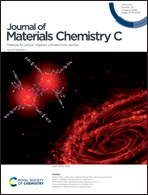Origin of the abnormal reduction of the dielectric response for ReCOB crystals and its mechanism: theoretical and experimental exploration†
Abstract
The dielectric performance of ReCOB-type (Re: rare earth ions) crystals is vital for modulating their electro-elastic properties and improving the sensing capabilities of such high temperature piezoelectric sensors. It has been reported that the dielectric permittivity of ReCOB increases with increasing Re3+ ion radius, whereas LaCOB exhibits an abnormal drop in the dielectric permittivity, which presents an obstacle to the optimization of the properties of ReCOB crystals. By using first-principle calculations and combining these with experiments, we found that both electronic hybridization and bond vibrations contribute to the dielectric permittivity of ReCOB. A significant decrease in dielectric permittivity for LaCOB can be attributed to the distinct reduction in the ionic displacement polarization. Charged antisite LaCa+ defects play an important role in improving the dielectric properties of LaCOB by changing the polarization direction. This suggests that it would be useful to increase the concentration of LaCa antisite defects by partially replacing La3+ with smaller ions, such as Y3+, Er3+, and Tm3+.



 Please wait while we load your content...
Please wait while we load your content...